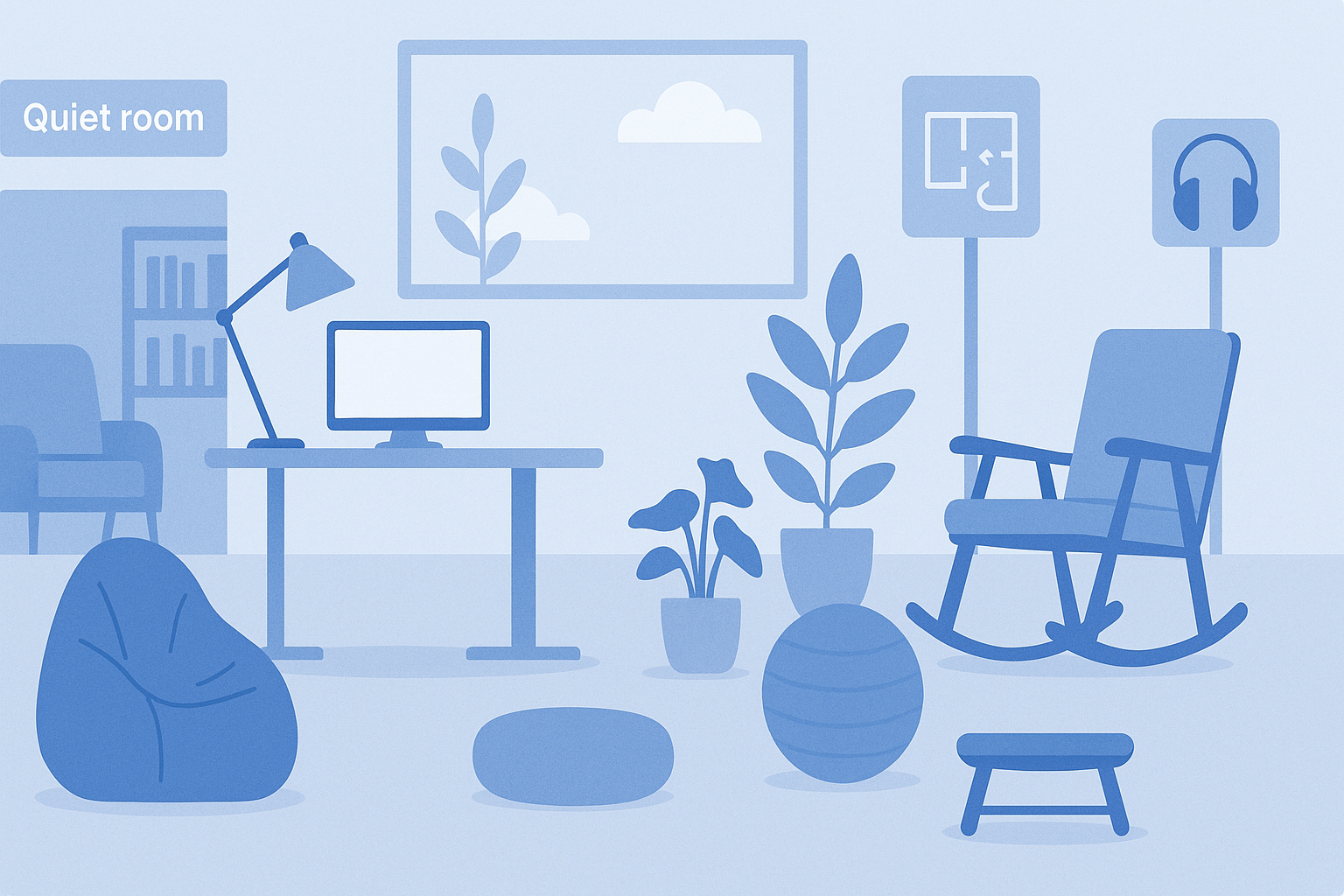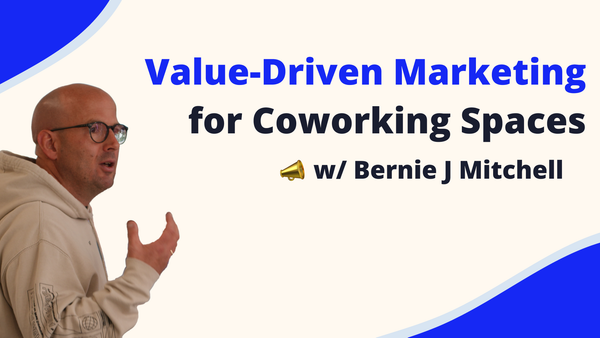Update Aug. 2025: Hear Aidan, the article’s author, explore accessibility, space design, and more on the Coworking Values Podcast:

Hi, I'm Aidan, and here's two fun facts:
- I'm neurodivergent
- I've gotten really good at finding the quietest seat in any coworking space.
I’ll pick the corner seat every time, the one farthest from the humming fridge and the chatter. I’ll schedule my deep work for off-peak hours. I might even “forget” my headphones once just to have an excuse to escape the fluorescent lighting (turns out, research agrees they’re sensory kryptonite for many neurodivergent folks).
But here’s the thing: what looks like “quirks” are just the blueprint for a better workspace. When I can customize my calendar colors (thanks, dyslexia), retreat to a quiet pod, or move freely between rooms, I’m finally operating at my full potential.
This isn’t about personal preference. It’s a design principle. Any community that cares about its members should be building with differences in mind. For businesses that care about innovation and equity, creating environments that support neurodivergent needs isn’t just the right thing to do—it’s also strategically sound.
Neurodivergent vs. Neurodiverse: A Quick Distinction
The terms “neurodivergent” and “neurodiverse” are sometimes wrongly used interchangeably. Here’s a quick breakdown on what they actually mean:
- Neurodivergent refers to individuals whose brain function differs from the dominant societal norm. This includes people with Autism Spectrum Disorder (ASD), Attention Deficit Hyperactivity Disorder (ADHD), Complex Post-Traumatic Stress Disorder (CPTSD), dyslexia, dyspraxia, and more.
- Neurodiverse describes the full range of neurological differences that exist in the human population. Not only is every brain unique, but sensory processing varies across the entire neurocognitive spectrum. In short, all brains are inherently neurodiverse!
Therefore, designing for neurodivergent people strengthens accessibility for the whole neurodiverse spectrum. And in coworking spaces—already built on the idea of flexibility—there’s a huge opportunity to lead by example.
Why Neuro-Inclusive Design Matters
Around 15-20% of the population is neurodivergent. Yet traditional office standards are often built around neurotypical preferences: bright lights, open-plan noise, and fixed desk arrangements. For many neurodivergent individuals, these conditions aren’t just inconvenient; they create real barriers to focus, regulation, and psychological safety.
And that’s a loss for everyone.
Designing for “average” leaves too much potential untapped. Neurodivergent people often bring heightened creativity, pattern recognition, innovation, and problem-solving to the table. But when the environment itself works against how their brains operate, those contributions can stay locked away.
Inclusive design unlocks that investment. It doesn’t just benefit neurodivergent employees, but also supports better outcomes for everyone. Research consistently links inclusive environments to stronger engagement, greater innovation, and higher performance. When the workspace flexes to fit different ways of working, people feel empowered to do their best work.
What Coworking Spaces Can Do

One important consideration in building a neurodivergent-friendly environment is sensory-aware design. Sensory processing differences are common among neurodivergent individuals, and environments that offer sensory balance, rather than overload, can significantly enhance well-being and productivity.
- Sensory-Zoned Rooms: A multi-environmental approach is recommended (and backed by science). Quiet, dimly lit rooms can support deep focus. Moderately stimulating spaces with natural light and plants can promote relaxed collaboration. Dynamic, high-energy rooms allow for social interaction and movement.
- Furniture Variety: Not everyone wants to sit in a standard office chair. Offer options: rocking chairs, floor cushions, bean bags, or stability balls. Let people stim (stimming is short for “self-stimulatory behavior,” like fidgeting, tapping, rocking, or any repetitive motion that helps regulate focus or calm the nervous system), move, or settle how their bodies need.
Flexibility is another key principle. Productivity does not follow a single rhythm, and workspaces work best when they accommodate diverse modes of attention, focus, and recovery.
- Custom Workstations: Let members personalize desks with their own sensory tools, lighting preferences, or focus aids. This subtle control can dramatically increase comfort.
Instead of forcing every space to be universally neutral, consider structuring the environment in layers of stimulation. Think of it as a gradient that allows people to match their energy or task to the right setting.
- Stimulation Gradient Planning: From low-noise deep-focus rooms to bright, shared problem-solving areas, this tiered structure helps people self-regulate and engage more consistently.
Navigation and visual design also impact cognitive ease. Unintuitive layouts or visual clutter can quickly become exhausting. Here’s what can be done to mitigate this:
- Minimalist Layouts: Prioritize clean spatial logic over decoration. Let the eye rest and the brain breathe.
- Wayfinding Tools: Clear icons, maps, and structured signage (all in a dyslexia-friendly font!) can help users orient themselves with ease.
Technology should be accessible and seamlessly integrated. What’s helpful for one person might be essential for another. Any assistive technology your space offers should be easy to find, reliable, visible, and customizable.
- Assistive Tech Readiness: Stock spaces with noise-canceling headphones, offer speech-to-text apps, and verify compatibility with various assistive devices.
Culture is the soil that gives all this design room to grow, and physical space alone does not cultivate inclusivity. The organizational culture must support and reinforce accessibility as an everyday norm.
- Normalize Variation: For coworking operators, this could mean allowing late-night or weekend access for members who work best outside typical hours, offering quiet corners for low-stimulation focus, and using simple signage on desks to indicate when someone is in deep focus mode. Announcing social events or maintenance disruptions in advance also helps members plan around their own energy and workflow needs.
- Train for Awareness: Provide practical neurodiversity education for staff and managers. Awareness leads to compassion and minimizes the burden of constant explanation for neurodivergent individuals.

Closing thoughts
Implementing all this can seem overwhelming, but inclusive design doesn’t need to be an all-or-nothing overhaul. Start by testing a few flexible features—maybe one quiet pod, some natural lighting adjustments, or neurodiversity training for staff. Gather feedback from neurodivergent folk. Adapt. The goal isn’t to be perfect. Prioritize being responsive.
Remember: Inclusive design is not an exception-making exercise.
By meeting the needs of those who are often excluded by default, you build a space where all workers can thrive. A well-designed space is not just inclusive; it is empowering. That is not charity. It is humanity, and it is good business.
PS: For a broader view on accessibility, we encourage reviewing our articles on coworking and online accessibility and web accessibility readiness.



